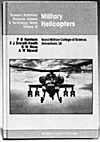
Modern military armaments are so extensive, from cartridges to computers, that even the professional soldier cannot be familiar with all facets of contemporary weaponry To provide an understanding of this complex subject, Brassey's has produced a continuing series to present the principles and varieties of the arms used by most military establishments.
Authored by experts in their fields, all lecturers at the Royal Military College of Science at Shrivenham, each volume is an authoritative compendium. Current weapons are identified and explained along with the procedures and tactics which will likely employ them. Historical development of certain weapon types, such as the tank, is included to show the evolution of these armaments. To enhance their value as instructional texts, every volume contains test questions after each chapter with answers at the back of the book. Illustrations of actual weapons, detailed diagrams of important mechanisms, and numerous charts facilitate this self education.
As might be expected, the arsenals of NATO receive wide coverage in the series. in the book on small arms (Vol. V), infantry weapons such as the FN FAL rifle and M60 machine gun are presented along with their attachments (blank firing devices, tripods, etc.). Experimental models, for example, the XV-15 Tilt Rotor Aircraft, are included with front-line helicopters such as the Huey Cobra (Vol. XI). Long time workhorses are shown with their likely replacements, as in the Hawk and Patriot missiles (Vol. VIII). For comparison, historical weapons and those of the Soviet Bloc are noted as representative types and for their performance characteristics.
Modern warfare is more than a function of armaments and protection from their wrath. The computer and its data processing equipment are becoming an important subspecialty in all armies. Both computer hardware and software are defined, and their battlefield representatives (TACFIRE) are identified (Vol. IX). As fighting units become smaller, more mobile, and better armed, their prompt identification during combat is crucial, so that surveillance and target acquisition systems will gain in sophistication (Vol. VII). The plethora of information generated by visual, electronic, and other means must be processed and acted upon quickly. Radios, landlines, and satellites (Vol. VI) are among the equipment used by the commander to gather data and disseminate orders to his sub- units in the field.
Any appreciation of high tech weapons must be based on a familiarity with the scientific principles which ultimately influence their performance. An overview of the problems facing the soldier and arms designer (Introduction to Battlefield Weapons Systems & Tecbnology) encourages further study of the different topics of guns, vehicles, etc. The actions and lethality of projectiles are delineated by the research of ballistics (Vol. X). Because nuclear weapons impinge on every conflict, just by their devastating potential, they rate a separate book (Vol. IV) which surveys the physics, effects, and safeguards of these devices. For anyone involved with modern weaponry or interested in its application, the multi-volume set by Brassey's will be a valuable tool and constant reference.
Brassey's Battlefield Weapons Systems & Technology Series
General Editor: Colonel R. G. Lee, Royal Military College of Science, Shrivenham, UK
Brassey's Defence Publishers, Ltd., a member of the Pergamon Group, distributed in the United States by Pergamon-Brassey's International Defense Publishers, 1340 Old Chain Bridge Road, McLean, Virginia 22101
Audiences: military officers and non-commissioned officers, researchers, wargamers, educators, students
Introduction to Battlefield Weapons Systems & Technology (1981)
Written by R.G. Lee
210 pp., 131 illustrations, glossary, index
Hardcover: $29.50 ISBN 0-08-027043-3
Flexcover: $15.00 ISBN 0-08-027044-1
Volume I, Vehicles & Bridging (1985)
Written by LEB. TytIer, N.H. Thompson, B. E. Jones, P.J. H. Wormell, and C.E.S. Ryley
239 pp., 169 illustrations, 3 tables, index
Hardcover: $26.00 ISBN 0-08-028322-5
Flexcover: $16.00 ISBN 0-08-028323-3
Volume II, Guns, Mortars, & Rockets (1982)
Written by JW Ryan
236 pp., 84 illustrations, glossary, bibliography, index
Hardcover: $26.00 ISBN 0-08-028324-1
Flexcover: $13 .00 ISBN 0-08-028325-X
Volume III, Ammunition (including Grenades & Mines) (1982)
Written by K.J.W. Goad and D.H.J. Halsey
306 pp., 147 illustrations, glossary, index
Hardcover: $35.00 ISBN 0-08-028326-8
Flexcover: $17.50 ISBN 0-08-028327-6
Volume IV, Nuclear Weapons & Their Effects (1984)
Written by L.W McNaught
150 pp., 46 illustrations, glossary, index
Hardcover: $27.00 ISBN 0-08-028328-4
Flexcover: $12.50 ISBN 0-08-028329-2
Volume V, Small Arms & Cannons (1982)
Written by C.J Marchant-Smith & PR Halsam
220 pp., 92 illustrations, glossary, index
Hardcover: $26.00 ISBN 0-08-028330-6
Flexcover: $13-00 ISBN 0-08-028331-4
Volume VI, Command, Control & Communications (C3) (1983)
Written by A.M. Wilcox, M.G. Slade and PA. Ramsdale
160 pp., 92 illustrations, glossary, index
Hardcover: $27.00 ISBN 0-08-028323-2
Flexcover: $12.50 ISBN 0-08-028333-0
Volume VII, Surveillance & Target Acquisition Systems (1983)
Written by A. L. Rodgers, I. B.R. Fowler, TK. Garland-Collins, J.A. Gould, D.A. Jones, W Roper
234 pp., 100 illustrations, glossary, index
Hardcover: $27.00 ISBN 0-08-028334-9
Flexcover: $12.50 ISBN 0-08-028335-7
Volume VIII, Guided Weapons (including Light, Unguided Anti-Tank Weapons (1983)
Written by R.G. Lee, TK. Garland-Collins, P Garnell, D. HJ Halsey, and A. W Mowat
238 pp., 120 illustrations, glossary, index
Hardcover: $27.00 ISBN 0-08-028336-5
Flexcover: $12.50 ISBN 0-08-028337-3
Volume IX, Military Data Processing & Microcomputers (1982)
Written by J. W D. Ward and G.N. Turner
225 pp., 84 illustrations, glossary, bibliography, index
Hardcover: $26.00 ISBN 0-08-028338-1
Flexcover: $13.00 ISBN 0-08-028399-X
Volume X, Military Ballistics: A Basic Manual (1983)
Written by C. L. Farrar and D.W Leeming
230 pp., 167 illustrations, glossary, index
Hardcover: $27.00 ISBN 0-08-028342-X
Flexcover: $12.50 ISBN 0-08-028343-8
Volume XI, Military Helicopters (1985)
Written by P.G. Harrison, E.J. Everett-Heath, G.M. Moss and A.W Mowat
155 pp., 106 illustrations, glossary, bibliography, index
Hardcover: $27.00 ISBN 0-08-029958-X
Flexcover: $15.00 ISBN 0-08-029959-8
Back to Table of Contents -- Game News #12
To Game News List of Issues
To MagWeb Master Magazine List
© Copyright 1986 by Dana Lombardy.
This article appears in MagWeb (Magazine Web) on the Internet World Wide Web.
Other military history articles and gaming articles are available at http://www.magweb.com